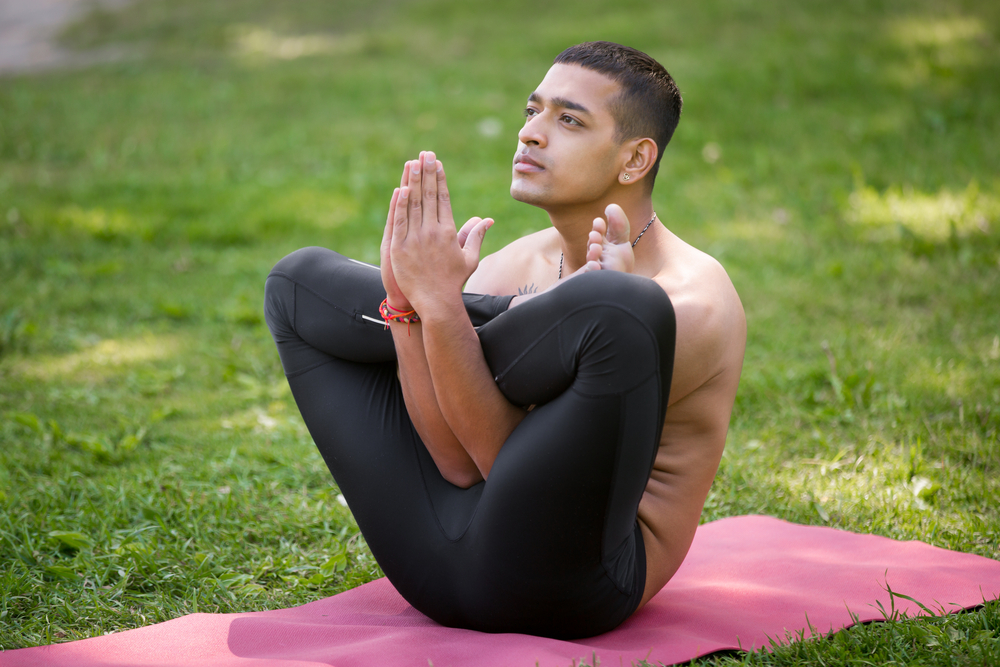Yoga, an ancient practice with roots in India, offers a myriad of benefits for both body and mind. Among its many postures, Garbha Pindasana, commonly known as the Embryo Pose, stands out for its unique blend of physical and mental benefits. This article delves into the nuances of Garbha Pindasana, exploring its origins, benefits, step-by-step instructions, expert insights, scientific evidence, and frequently asked questions.
What is Garbha Pindasana?
Garbha Pindasana is derived from the Sanskrit words “Garbha,” meaning womb or embryo, and “Pindasana,” which translates to “ball” or “form.” The pose mimics the position of a fetus in the womb, creating a sense of security and introspection. It is often practiced in Ashtanga Yoga and is known for promoting physical stability, mental clarity, and emotional calmness.
The Origins of Garbha Pindasana.
Garbha Pindasana has its roots in ancient Indian philosophy and yoga texts. The pose is mentioned in various classical texts, including the “Hatha Yoga Pradipika,” which emphasizes the importance of postures in achieving a balanced mind and body. Traditionally, yoga was not just a physical practice but a holistic approach to wellness, spirituality, and self-discovery.
Benefits of Garbha Pindasana.
1. Physical Benefits.
Garbha Pindasana offers several physical benefits:
– Improves Flexibility: The pose stretches the hips, thighs, and lower back, enhancing overall flexibility.
– Strengthens Core Muscles: Engaging the core during the pose helps build strength in the abdominal muscles.
– Promotes Better Posture: By encouraging spinal alignment, Garbha Pindasana helps improve overall posture.
– Enhances Circulation: The fetal position facilitates blood flow, aiding in detoxification and nourishment of the body.
2. Mental Benefits.
Garbha Pindasana is not only beneficial for the body but also for the mind:
– Fosters Calmness: The enclosed position encourages introspection and calmness, helping to alleviate anxiety and stress.
– Enhances Focus: Practicing this pose can improve concentration and mental clarity.
– Promotes Mindfulness: The pose encourages practitioners to be present and aware, fostering a deeper connection to their bodies.
3. Emotional Benefits.
Engaging in Garbha Pindasana can also lead to emotional healing:
– Encourages Inner Peace: The pose promotes a sense of safety and security, allowing individuals to explore their emotions.
– Facilitates Emotional Release: Practicing this pose can help release pent-up emotions and create space for healing.
Step-by-Step Guide to Performing Garbha Pindasana.
Before attempting Garbha Pindasana, it’s important to warm up your body with preparatory poses such as Downward Dog, Child’s Pose, and other hip-openers.
Step 1: Start in a Seated Position.
Begin by sitting on the mat in a comfortable cross-legged position. Ensure your spine is straight and your shoulders are relaxed.
Step 2: Bring Your Feet to Your Chest.
Bend your knees and bring your feet close to your chest. Your knees should be wide apart.
Step 3: Wrap Your Arms Around Your Legs.
Take your arms and wrap them around your legs, gripping your feet. If you can’t reach your feet, it’s perfectly fine to hold your shins or thighs.
Step 4: Tuck Your Chin.
Gently tuck your chin into your chest, allowing your forehead to move toward your knees. This action mimics the fetal position.
Step 5: Hold the Pose.
Stay in this position for several breaths, focusing on your breathing and the sensations in your body. You can hold the pose for 30 seconds to a minute.
Step 6: Release.
To come out of the pose, slowly release your feet and return to a seated position. Take a moment to notice how your body feels.
Expert Insights: Interviews with Yoga Practitioners.
To gain a deeper understanding of Garbha Pindasana, I spoke with two experienced yoga instructors, Sarah Thompson and Raj Patel, who shared their insights on the pose.
Sarah Thompson, Yoga Instructor for Over 10 Years.
Q: What are the key benefits of Garbha Pindasana?
A: “Garbha Pindasana is a wonderful pose for grounding and centering oneself. It not only stretches the body but also offers a unique opportunity for introspection. Many of my students find comfort in the fetal position, as it helps them connect with their emotions and find inner peace.”
Raj Patel, Ashtanga Yoga Practitioner
Q: How do you incorporate Garbha Pindasana into your practice?
A: “I often use Garbha Pindasana as a transitional pose. It helps to create a sense of calm before moving into more challenging postures. The key is to maintain a steady breath and embrace the stillness that the pose offers.”
Scientific Evidence Supporting the Benefits of Garbha Pindasana.
Numerous studies have examined the physiological and psychological benefits of yoga practices, including poses like Garbha Pindasana. A study published in the Journal of Behavioral Medicine found that yoga can significantly reduce stress and anxiety levels, leading to improved mental health.(1)
Additionally, research in the International Journal of Yoga found that practicing yoga regularly enhances flexibility, strength, and balance. The physical aspects of poses like Garbha Pindasana contribute to overall well-being, making it an essential part of a balanced yoga practice.(2)
Frequently Asked Questions.
Yes, Garbha Pindasana can be practiced by beginners. However, it’s essential to listen to your body and modify the pose if necessary. If you find it challenging to hold your feet, you can hold your shins or thighs instead.
To reap the benefits, aim to practice Garbha Pindasana at least two to three times a week. Incorporating it into your regular yoga routine can enhance its effectiveness.
While the pose itself is beneficial for promoting calmness and relaxation, pregnant individuals should consult their healthcare provider before practicing any yoga poses. Modifications may be necessary to ensure safety.
Common mistakes include forcing the body into the pose, holding the breath, and neglecting spinal alignment. It’s important to maintain a steady breath and keep the spine elongated.
To enhance your practice, focus on deep breathing and mindfulness. Use props like blankets or blocks for added support and comfort. Regularly practicing preparatory poses will also help improve flexibility and strength.
Bottom Line.
Garbha Pindasana, or the Embryo Pose, is a powerful yoga posture that provides a multitude of physical, mental, and emotional benefits. By embracing the fetal position, practitioners can foster a sense of calm, enhance flexibility, and deepen their connection to their bodies.
Whether you’re a seasoned yogi or a beginner, incorporating Garbha Pindasana into your practice can be transformative. With expert insights and scientific evidence supporting its benefits, this pose is a valuable addition to any yoga routine. As you explore Garbha Pindasana, remember to approach the pose with mindfulness and compassion for yourself, allowing it to guide you toward inner peace and well-being.
+2 Sources
FitnessQuora has strict sourcing guidelines and relies on peer-reviewed studies, educational research institutes, and medical organizations. We avoid using tertiary references. You can learn more about how we ensure our content is accurate and up-to-date by reading our editorial policy.
- How Does Yoga Reduce Stress? A Clinical Trial Testing Psychological Mechanisms; https://pmc.ncbi.nlm.nih.gov/articles/PMC10159010/
- Exploring the therapeutic effects of yoga and its ability to increase quality of life; https://pmc.ncbi.nlm.nih.gov/articles/PMC3193654/

 Workout
Workout
 Meditation
Meditation





 Contact Us
Contact Us





